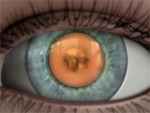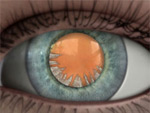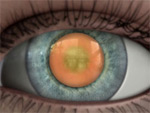
Blepharitis Can Occur as Greasy Flakes or Scales along the Base of the Eyelashes
BLEPHARITIS
Blepharitis is an inflammation of the eyelids causing red, irritated, itchy eyelids and the formation of dandruff-like scales on eyelashes. It is a common eye disorder caused by either bacterial or a skin condition such as dandruff of the scalp or acne rosacea. It affects people of all ages. Although uncomfortable, blepharitis is not contagious and generally does not cause any permanent damage to eyesight.
Anterior blepharitis is commonly caused by bacteria (staphylococcal blepharits) or dandruff of the scalp and eyebrows (seborrheic blepharitis). It may also occur due to a combination of factors, or less commonly may be the result of allergies or an infestation of the eyelashes.
Posterior blepharitis can be caused by irregular oil production by the glands of the eyelids (meibomian blepharitis) which creates a favorable environment for bacterial growth. It can also develop as a result of other skin conditions such as acne rosacea and scalp dandruff.
Information Courtesy of the American Optometric Association. For more information please click on this link: www.aoa.org/Blepharitis.xml
CATARACT
A cataract is a cloudy or opaque area in the normally clear lens of the eye. Depending upon its size and location, it can interfere with normal vision. Most cataracts develop in people over age 55, but they occasionally occur in infants and young children. Usually cataracts develop in both eyes, but one may be worse than the other. Reasearchers have linked eye-friendly nutrients such as lutein/zeaxanthin, vitamin C, vitamin E, and zinc to reducing the risk of certain eye diseases, including cataracts. For more information on the importance of good nutrition and eye health, please see the diet and nutrition section.
The lens is located inside the eye behind the iris, the colored part of the eye. The lens focuses light on the back of the eye, the retina. The lens is made of mostly proteins and water. Clouding of the lens occurs due to changes in the proteins and lens fibers.
The lens is composed of layers like an onion. The outermost is the capsule. The layer inside the capsule is the cortex, and the innermost layer is the nucleus. A cataract may develop in any of these areas and is described based on its location in the lens:
- A nuclear cataract is located in the center of the lens. The nucleus tends to darken changing from clear to yellow and sometimes brown.
- A cortical cataract affects the layer of the lens surrounding the nucleus. It is identified by its unique wedge or spoke appearance.
- A posterior capsular cataract is found in the back outer layer of the lens. This type often develops more rapidly



Normally, the lens focuses light on the retina, which sends the image through the optic nerve to the brain. However, if the lens is clouded by a cataract, light is scattered so the lens can no longer focus it properly, causing vision problems.
Cataracts generally form very slowly. Signs and symptoms of a cataract may include:
- Blurred, hazy, or vision
- Reduced intensity of colors
- Increased sensitivity to glare from lights, particularly when driving at night
- Increased difficulty seeing at night
- Change in the eye’s refractive error
While the process of cataract formation is becoming more clearly understood, there is no clinically established treatment to prevent or slow their progression. In age-related cataracts, changes in vision can be very gradual. Some people may not initially recognize the visual changes. However, as cataracts worsen vision symptoms tend to increase in severity.
Information courtesy of the American Optometric Association. For more information, please click on the following link: www.aoa.org/cataract.xml
Service Areas
- Granbury, TX
- Glen Rose, TX
- Acton, TX
- Bluff Dale, TX
- Cresson, TX
- De Cordova, TX
- Lipan, TX
- Nemo, TX
- Paluxy, TX
- Pecan Plantation, TX
- Rainbow, TX
- Tolar, TX
- Godley, TX
- Burleson, TX
- Cleburne, TX


